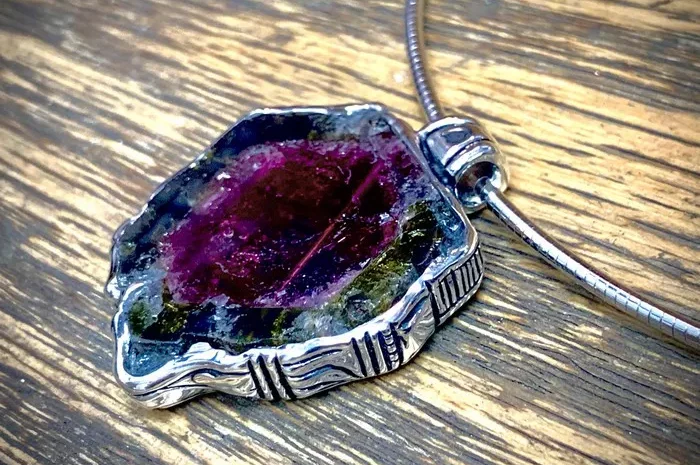Black tourmaline, a member of the tourmaline family, is a gemstone known for its unique properties and diverse color range. While tourmaline can exhibit a wide spectrum of colors, from the vibrant hues of red and blue to the subtle shades of green and black, black tourmaline stands out with its deep, mysterious appearance. This gemstone has been admired for centuries for its beauty and is often used in jewelry and decorative items. However, as a jewelry appraiser, it is crucial to understand the effects of sunlight on black tourmaline and how to properly care for this gemstone.
Sunlight Exposure and Black Tourmaline
The Impact of Sunlight
Sunlight, while essential for life on Earth, can have varying effects on gemstones, including black tourmaline. Ultraviolet (UV) rays from the sun can cause several changes in gemstones, including fading of color, cracking, and even chemical alterations. For black tourmaline, prolonged exposure to direct sunlight can lead to several issues:
Color Fade: Although black tourmaline is known for its dark hue, prolonged sunlight exposure can cause subtle changes in its color. Over time, the gemstone may lose its deep black appearance, developing lighter patches or a more muted tone.
Thermal Stress: Black tourmaline, like other gemstones, can expand and contract when exposed to temperature changes. Direct sunlight can cause rapid heating, leading to thermal stress within the gemstone. This stress can result in cracks or fractures, compromising the structural integrity of the gemstone.
Chemical Alteration: In some cases, prolonged sunlight exposure can cause chemical changes within the gemstone. These changes can alter the gemstone’s composition, leading to a loss of luster or a change in its optical properties.
Safe Handling Practices
To protect black tourmaline from the adverse effects of sunlight, it is essential to follow safe handling practices:
Store in a Cool, Dark Place: When not in use, store black tourmaline in a cool, dark place. This will minimize exposure to UV rays and help maintain the gemstone’s original color and properties.
Avoid Direct Sunlight: Never leave black tourmaline in direct sunlight for extended periods. If you must expose it to sunlight, do so briefly and ensure it is not in direct contact with intense UV rays.
Use a UV-Protective Case: If you need to transport or store black tourmaline in a location where sunlight exposure is unavoidable, consider using a UV-protective case. This will provide an additional layer of protection against harmful UV rays.
Jewelry Appraisal and Black Tourmaline
As a jewelry appraiser, understanding the characteristics and care requirements of black tourmaline is crucial for accurate assessment and valuation. Here are some key factors to consider when appraising black tourmaline jewelry:
Color and Clarity
Color and clarity are two critical factors that affect the value of black tourmaline. While black tourmaline is primarily valued for its deep black hue, variations in color saturation and tone can impact its appearance and, consequently, its value. A well-saturated, evenly colored black tourmaline will typically command a higher price than one with lighter patches or uneven color distribution.
Clarity refers to the internal purity of the gemstone. Black tourmaline can contain inclusions, such as minerals or cracks, which can affect its transparency and overall appearance. Gemstones with fewer and smaller inclusions are generally more valuable.
Cut and Shape
The cut and shape of black tourmaline also play a significant role in determining its value. A well-cut gemstone will maximize its brilliance and fire, enhancing its visual appeal. The shape of the gemstone can also affect its perceived size and overall look. Popular shapes for black tourmaline include rounds, ovals, cushions, and cabochons.
Carat Weight
Carat weight is another important factor in valuing black tourmaline. Larger gemstones are generally more rare and, therefore, more valuable. However, it is essential to consider the overall quality of the gemstone in addition to its size. A larger gemstone with poor color or clarity may not command a higher price than a smaller, but higher-quality one.
Origin and Treatment
The origin of the black tourmaline can also affect its value. Gemstones from certain mines or regions may be more sought-after due to their unique characteristics or historical significance. Additionally, the treatment history of the gemstone is crucial. Natural, untreated black tourmaline is typically more valuable than treated stones, as treatments can alter the gemstone’s properties and appearance.
Market Demand and Trends
Finally, market demand and trends play a significant role in determining the value of black tourmaline. As with any commodity, the price of gemstones can fluctuate based on supply and demand. Popularity, fashion trends, and cultural preferences can all influence the demand for black tourmaline, affecting its price.
Conclusion
In conclusion, black tourmaline is a unique and beautiful gemstone that requires careful handling to maintain its original properties and appearance. As a jewelry appraiser, understanding the effects of sunlight on black tourmaline and following safe handling practices is essential for accurate assessment and valuation. By considering factors such as color, clarity, cut, carat weight, origin, treatment, and market demand, jewelry appraisers can provide valuable insights into the quality and value of black tourmaline jewelry. With proper care and consideration, black tourmaline can continue to shine as a cherished gemstone for generations to come.
Related topic:
- How to Identify Green Tourmaline
- How to Choose the Right Amazon Tourmaline Necklace for Yourself?
- What Is Green Tourmaline Stone


